
Fast, affordable Internet access for all.


Newark, New Jersey (pop. 307k) has been operating a dark fiber network for more than a decade. In recent years, the city has expanded its efforts to leverage those assets in an incremental effort to improve connectivity and competition for local business and residents, while also building out a robust Wi-Fi network. The goal: build a portfolio of approaches to connect the last twenty percent of the city that doesn't have access today.
This week on the podcast, Christopher is joined by Aaron Meyerson, Chief Innovation Economy Officer and Director of Broadband, and Anthony Avent, Technical Operations for City of Newark, to talk about the project. From reinvigorating the city's infrastructure with a new public-private partnership, to connecting almost a hundred large business locations, to enabling innovative smart-city applications to fight heat and pollution, to supporting more than 7,200 active Wi-Fi users every day, Newark isn't just sitting around waiting for someone to help solve local challenges. They're stepping up to the plate and tackling them themselves.
This show is 28 minutes long and can be played on this page or using the podcast app of your choice with this feed.
Transcript below.
We want your feedback and suggestions for the show: please e-mail us or leave a comment below.
Listen to other episodes here or see other podcasts from the Institute for Local Self-Reliance here.
Thanks to Arne Huseby for the music. The song is Warm Duck Shuffle and is licensed under a Creative Commons Attribution (3.0) license.
In an announcement last week, Alexandria, Minnesota's (pop. 15,000) electric and water utility (ALP Utilities) announced it would be selling its business-facing fiber network to Arvig, a 40-percent employee-owned Internet Service Provider (ISP) that has 54,000 subscribers across urban and rural Minnesota. The deal was for 130 business accounts, including 77 routes miles of fiber and 13 additional miles of conduit, for a total of $3.25 million. Consideration of the move goes at least back to October of last year.
A Practical Solution With Added Local Benefits
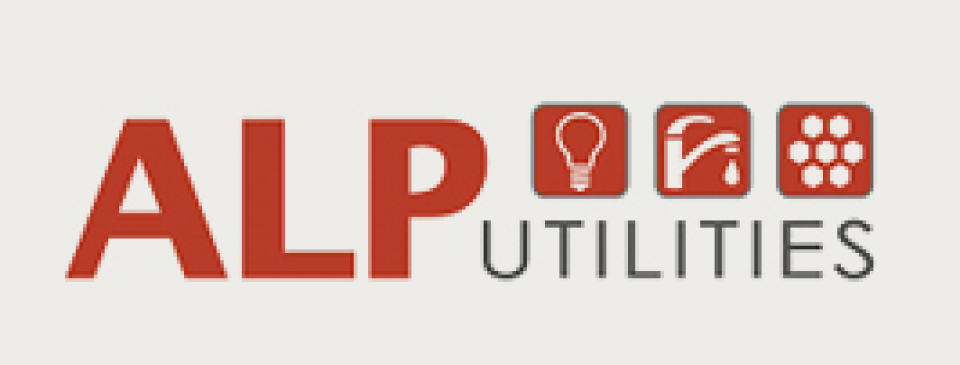
The move sunsets the last of the city's retail municipal network infrastructure, which began as a joint project with Runestone Electric Association in the 1990s that offered DSL service to homes and businesses before expanding to include some fiber offered to local businesses in the early 2000s, and continued today with some additional dark fiber offerings as part of its portfolio. The goal, then as now, was to see how the utility could intervene to improve connectivity options for residents in the area. Christopher spoke with General Manager Al Cowser in 2016 about the efforts' origins and progress in its first two decades of life.
To that end, the deal made sense, shared current General Manager Ted Cash in an interview with ILSR. The financial modeling the utility did when it considered expanding the fiber network to a larger proportion of the city, including the hiring of the staff required to run services in-house, didn't return the numbers they needed to make it work, he also said.
The final Board vote took place on January 17th via Resolution No. 2023-01, with no opposition.
What Happens Next?
Over the past several months, we’ve recounted trials and tribulations as we tried to obtain a telephone power cord from CenturyLink. The saga has taken us through the horrors of Halloween to an odd fall Groundhog Day, and now we’re happy to report that our hero recently celebrated an early Christmas. The phone power cord has finally arrived.
In order to memorialize the event, we recorded John opening the package from CenturyLink. Against all odds, it WAS the correct cord.
All He Wanted Was A Phone Cord
 As a recap, the CenturyLink Saga actually began on August 22, 2018, when our Co-Director and head of the Energy Democracy Initiative, John Farrell, contacted our Internet access and VoIP provider to request a phone cord. If you read the first story in the series, you’ll remember that a phone he ordered for a new hire came with no power cord in the box. Seems like a simple request, but is there such as thing as a "simple request" when dealing with a massive, inefficient bureaucracy such as CenturyLink?
As a recap, the CenturyLink Saga actually began on August 22, 2018, when our Co-Director and head of the Energy Democracy Initiative, John Farrell, contacted our Internet access and VoIP provider to request a phone cord. If you read the first story in the series, you’ll remember that a phone he ordered for a new hire came with no power cord in the box. Seems like a simple request, but is there such as thing as a "simple request" when dealing with a massive, inefficient bureaucracy such as CenturyLink?
What He Got Was A Trip on A Hamster Wheel
From that moment on, John was mindlessly shuffled from sales associate to “help” desk, and eventually routed back the first person he reached out to for help. When he expressed his frustration on Twitter, CenturyLink was all over the problem, tweeting that they could help him if he would just direct message him. He obliged, only to be sent through the same maze once more after being ignored after some weeks. The final response, after CenturyLink had wasted John’s time was, “We don’t provide power cords for the phone. I apologize.”
He Had to Let the World Know
As they look back over their accomplishments, the Roanoke Valley Broadband Authority (RVBA) has more than the holidays to celebrate at the close of 2018. In addition to stimulating competition in the region, the RVBA network is attracting more investment and helping local nonprofits operate more efficiently.
Dual Purpose
For Feeding America Southwest Virginia in Salem, connectivity from RVBA is critical. “Without that Internet connection reliability, it would be very difficult for us to achieve our mission,” says IT Director Eric Geist. The food bank is one of the enterprise customers that the RVBA serves in the region, providing affordable access to organizations and institutions such as nonprofits, businesses, and institutions.
By providing affordable connectivity and services focused on the needs of businesses, the RVBA network has helped drive competition in the region. According to CEO Frank Smith’s research, prices have dropped 25 - 30 percent. The change squares with the RVBA mission to enhance and promote economic development by improving connectivity services and prices in Salem, Roanoke, and the counties of Roanoke and Botetourt. They've seen results in the past three years with greater expectations ahead.
The History
Before the network, the valley was caught in a connectivity “donut hole.” The populations in Salem and Roanoke had access to some cable Internet access and were large enough to prevent the region from obtaining grants to entice providers to upgrade. In 2013, local governments decided to work together to improve connectivity and funded a feasibility study, which recommended an open access network.
Halloween is less than a week away, but our horrifying tale of customer service terror is quickly turning into science fiction in which we are caught in an never-ending loop bending time and space. Time for a quick update.
As a refresher, our Halloween story relayed the difficulties ILSR has had in recent months with CenturyLink, which provides Internet access and VoIP service to our Minneapolis office. When we received a new phone for a new employee, there was no AC power cord in the box. After running on a human hamster wheel for months, one of our Co-directors, John Farrell, who had been shuffled from department to department at the ISP in search of a cord had been told that he could continue to try to get one from the company or just buy one on Amazon.
It didn’t take long for CenturyLink to reach out to us, once we shared our story via Twitter, telling us that they were “saddened” by our negative experience with the phone power cable and letting us know that, if we would reach out to them, they’d be happy to help.
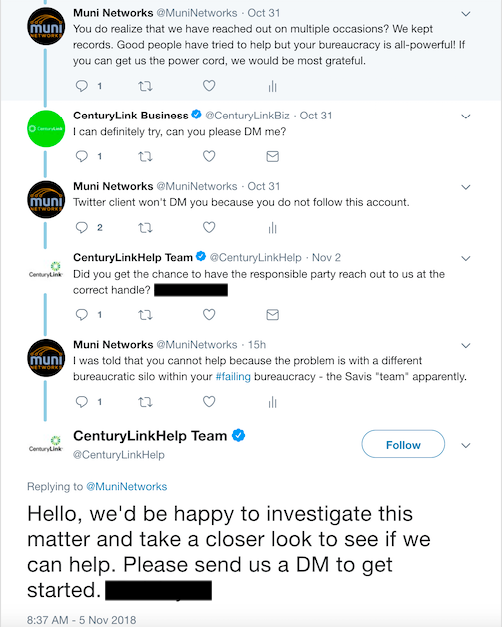
Anxious to get the conversation out of the public sphere, CenturyLink employees managing the Twitter account requested we direct message them, which we did.
It didn't take long for the nightmare to start all over again as we were looped into an endless version of "Groundhog Day," repeating ourselves and once again being passed from one customer service representative to the next. We've blocked out their names, because we realize that it isn't their fault that the behemoth that they work for is too massive to work efficiently. Over the course of several days, we interacted with several different people, each not completely aware of what the other had been up to in order to tend to our issue.
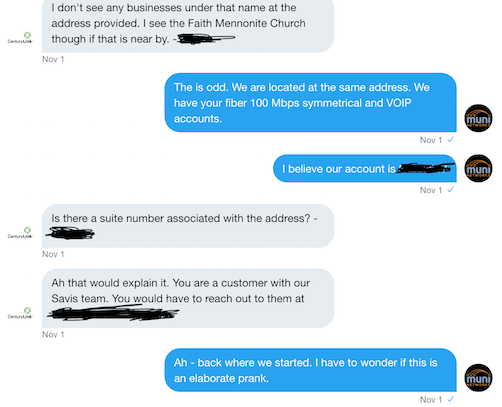
After sharing the DMs displaying the endless cycle with our Twitter followers, CenturyLink once again asked us put a lid on the conversation. We yielded, but they would not accept our surrender.
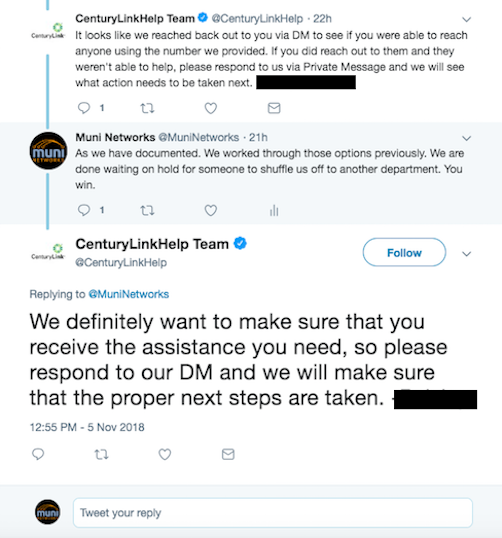
Ghastly ghouls, horrific monsters, and vile flesh-eating creatures roam the earth this night of Halloween, but none evince the evil that has of late entered the halls of ILSR. One of our own has faced the torture of an entity bent on pushing him over the precipice of human endurance, twisting his psyche with the torment of nonsense, and claiming his head for their own.
On past Halloweens we’ve written fun, spooky content about scary telecom monsters and frightening tricks; this year we relay the haunting, dramatic tale of John Farrell and The Legend of CenturyLink Hell.

The Hamster Wheel of Phone Cord Purgatory
Unlike Icabod Crane of gothic New England lore, John's head has stayed firmly attached at the neck, but recent encounters with the office Internet service provider have lead him to that dark place where so many others have accidentally strayed - into the no man's land of customer service decapitation.
It all began with a new phone for the office. John, newly appointed Co-Director of the Institute for Local Self-Reliance and the head of the Democratic Energy Initiative, had ordered phones from ILSR’s Internet access provider in the past. CenturyLink, which provides VoIP, had provided the physical phones before with no issue, but this time there was no power adapter included in the package. Thinking the oversight would be easily remedied was John's first mistake ... and the first step on his journey into hell.
John reached out to the sales associate who he had worked with when ILSR switched from Comcast to CenturyLink’s fiber service. He explained that the new phone ILSR received didn’t include a power adapter and asked them to order one. To John's surprise and dismay, the sales associate told John that they couldn’t order a solo adapter and referred John to the Mac Desk at CenturyLink. He reached out to the sales people at the Mac Desk, but the answer he received was cold comfort that stirred an uneasy feeling in his bowels.
On October 24, the Aurora, Illinois, City Council Finance Committee approved a $40,000 grant to OnLight Aurora to extend the city’s fiber optic network to River Street Plaza area commercial properties.
The City of Light And Dark Fiber
OnLight Aurora is the nonprofit ISP that leases publicly owned fiber optic infrastructure to serve the city’s municipal government, community anchor institutions (CAIs), two data centers (Bytegrid and CyrusOne) and local businesses.
Prior to OnLight Aurora’s network, the city’s previous network was a patchwork of varying speeds and capabilities. The network was old, unreliable for government employees, and expensive. In 2005-2006, city leaders estimated that Aurora was paying nearly $500,000 a year for leased line expenses to telecommunications providers. Now, the city of Aurora saves approximately $485,000 each year by utilizing their municipal fiber optic infrastructure.
Sandpoint, Idaho’s fiber-optic infrastructure is ready to lease to Internet Service Providers (ISPs) interested in serving the north Idaho town. A regional provider recently announced that it will take advantage of the community’s fiber to expand its network by leasing dark fiber from the city to serve local commercial subscribers.
Big Plans Begin To Unfold
The city installed fiber during road project construction over a five-year period. About a year ago, Sandpoint released a Request for Proposals (RFP) to help the community of 9,700 people make strategic use of its dark fiber network. In addition to leasing dark fiber to providers, the network will serve municipal needs such as public safety and city offices. In February, the City Council established rates for dark fiber leasing and maintenance.
Things have been somewhat quiet until Intermax Networks announced that it has entered into an agreement with the city to lease excess capacity on Sandpoint’s network and will use the new infrastructure to offer connectivity to local commercial subscribers.
President Max Kennedy said in an official statement:
"We’ve provided fiber services to commercial businesses in Sandpoint for years, but today we are proud to be the first private partner with the City of Sandpoint to expand our network by licensing space on the city’s new fiber infrastructure.
…
Sandpoint has been an integral part of Intermax since the company was founded in Sandpoint in 2001. This year we are going to be dramatically expanding our service capacity in Sandpoint, and we’re pleased to be working with the city on this great project."
Intermax serves commercial sites throughout northern Idaho with fiber and connects to peer networks in Seattle and Portland. The company also provides a variety of services to residential customers and anchor institutions in Kootenai, Bonner, Boundary, and Spokane Counties.
Don't Forget Mr. And Mrs. Sandpoint
In 2004, about 90 percent of multi-tenant company-owned buildings were not connected to fiber for connectivity. In April, Vertical Systems Group revealed that in 2016 that number had dropped to 50.4 percent. The results underscore the fact that businesses understand the importance of fiber as a basic commercial amenity and strive to obtain it in their own facilities.
“Fiber footprints have been highly valued assets in nearly every merger transaction in the industry during the past two years. The density of fiber lit buildings on-net and geographic reach are significant competitive differentiators,” said Rosemary Cochran, principal at Vertical Systems Group. “For 2017, network providers report that fiber footprint expansion is the top factor that will drive Carrier Ethernet growth and support rising demand for other gigabit-speed services.”
In addition to data transport and online commerce, companies need high capacity and reliable connectivity to share files with potential partners. Depending on the type of work they do, transactions may depend on split second data delivery, which only fiber can provide.
As an increasing number of communities consider investing in fiber-optic networks, economic development is often cited is their first consideration. Without fast, affordable, reliable connectivity readily available, companies looking to relocate will move on and take jobs with them.
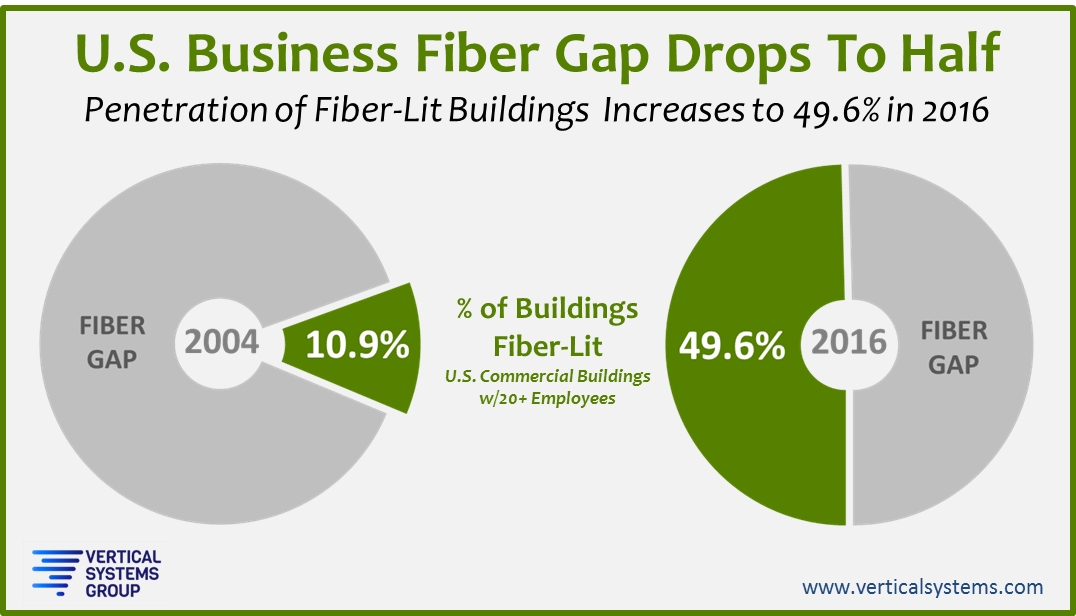
In January 2016, Holland, Michigan, made commencing fiber-optic Internet access to residential neighborhoods its number one goal for fiscal year 2017. They’re a little behind schedule, but the town is now moving forward by expanding a pilot project in order to serve a larger downtown area.
It's Really Happening
The Holland Board of Public Works (BPW) held an informational meeting on March 13th to answer questions from the community and share plans for the potential expansion. About a year ago, we reported on the results of a study commissioned by the city in which, based on a take rate of about 40 percent, 1 Gigabit per second (1,000 Mbps) connectivity would cost residents about $80 per month. Small businesses would pay approximately $85 per month and larger commercial subscriber rates would run around $220 per month. The update on the plan confirms those figures, noting that the four businesses that tested the pilot services had positive experiences. As a result, BPW feels it’s time to expand to more of downtown.
"If it goes really well we hope to be able to expand the service out as far into the community as we can," said Pete Hoffswell, broadband services manager at BPW.
The expansion is planned for construction in June and July, with service testing in August. Actual delivery would be in September, BPW estimates.
BPW will use a boring technique to place conduit and fiber below ground so there will be minimal disruption. No streets will be closed. Next, BPW will get construction bids, evaluate them, and present them to the City Council for approval.
Not An Impulse Decision
 Holland has had dark fiber in place for decades for the municipal electric operations. Later BPW extended it to schools and businesses that needed high capacity data services. After years of incremental expansions, the network is now more than 150 fiber miles throughout the city.
Holland has had dark fiber in place for decades for the municipal electric operations. Later BPW extended it to schools and businesses that needed high capacity data services. After years of incremental expansions, the network is now more than 150 fiber miles throughout the city.